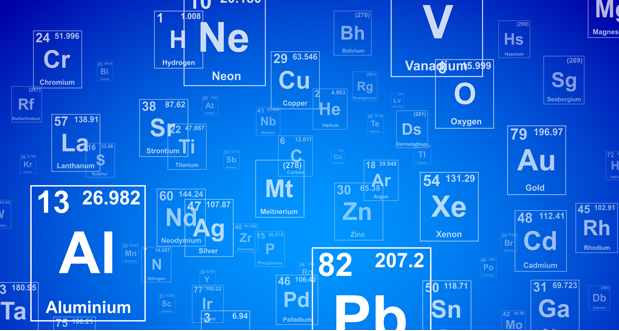

In March 1869, Russian scientist Dmitri Mendeleev arranged all known chemical elements into a table, in rows of atomic number from left to right. Mendeleev wrote in his diary:
“I saw in a dream a table where all the elements fell into place as required. Awakening, I immediately wrote it down on a piece of paper.”
One hundred and fifty years later, Mendeleev’s table is used every day in labs, classrooms and institutions across the world. Usually, when we think of the elements, we picture them in the tabular format of which Mendeleev had the original idea.
But within 100 years of the appearance of Mendeleev’s Periodic Table, it is thought that around 700 different versions were published, all taking many shapes and forms in different dimensions, from spirals, cylinders and rings, to fractals and pyramids.

Some of the designers responsible for these new versions thought the tabular form had limitations that they wanted to improve upon; others wanted to make the elements easier to comprehend or accommodate for new discoveries. Others still just wanted to create informative art that would look great on their wall. Let’s take a look at some of the most memorable versions.
Just as Mendeleev wasn’t the last to arrange the chemical elements, he wasn’t the first. Frenchman Alexandre-Émile Béguyer de Chancourtois can claim this feat, having arranged the elements in order of atomic weight in 1862 (figure 1).

De Chancourtois, a geologist, drew the elements around a metal cylinder, with similar elements – such as alkali metals lithium, sodium and potassium – lined up vertically. He called his creation “telluric helix” because tellurium was placed in the middle.
Unfortunately, when de Chancourtois had his work published, the diagram of his helix was left out, meaning it was somewhat overlooked upon its original publication.
In 1935, Emil Zmaczynski was one of the many to think outside of the tabular format with his periodic triangle, which graphically represents the process of constructing electron shells for atoms (figure 2).

Many of the redesigns of Mendeleev’s table down the years have ditched the grid in favour of a spiral. One of the benefits of such a design over the tabular form is that it glues together the split that occurs at each end of the table, thus connecting elements at either end that potentially have similar characteristics.
Gustavus Hinrichs can lay claim to the first periodic spiral. In fact, the German chemist proposed the design in 1867 – two years before Mandeleev’s table – with elements arranged based on mass (figure 3). But the Hinrichs spiral showed primary relationships between the elements and lacks the detail of later versions.

Figure 4. Image: DePiep/Wikimedia Commons
In 1949, Life Magazine published a somewhat more fleshed out spiral, or rather part spiral, part Olympic racing track. Elements are arranged based on number of electrons, starting with hydrogen in the middle. The magazine said: “The colours and construction of the table express another kind of relationship among the elements: the repetition, at regular intervals, of the chemical properties of the first few.”
Similarly, Theodor Benfey’s fleshed out spiral from 1964 starts at hydrogen in the centre and winds in a (sort-of) circle, with diversions around the lanthanides and actinides, and transition metals (figure 4).

Figure 5. Image: Jeff Moran
With an easy to follow structure and colour coding, Benfey’s spiral or “snail”, illustrates the elements in a more engaging way. Each colour represents a group of elements and each spiral represents a period on the traditional periodic table. Atomic numbers and masses are notably absent, however.
A more recent iteration, software developer Jeff Moran’s version tries to better illustrate hydrogen’s relationship with multiple elements, again by putting it at the centre (figure 5).

Figure 6. Image: Mitch Fincher
“I thought the spiral had more potential to show the interrelations of the elements than the Periodic Table,” he said. “The arrangement could get at the underlying philosophy as to why some elements attract other elements, why some are useful in conversion and why some are useful for protection.”
Blogger Mitch Fincher created the Mayan Periodic Chart in the early 1990s, taking inspiration from the Mesoamerican calendar (figure 6). The psychedelic ring is made of concentric circles, each containing elements ordered according to their atomic number.
Fincher told Laboratory News: “The Mayan Periodic chart came to me about 30 years ago while trying to create a three dimensional periodic table. I came up with the idea of concentric circles representing electron shells after pondering the lack of symmetry in the traditional one.

“For most uses Mendeleev’s table is superior, but the Mayan is useful for teaching and its sheer symmetry and beauty.”
Groups of elements are all arranged in different colours, including the noble gases, which are in a vertical column through the centre. What’s neat about the ring is that the more stable elements are on one side of the noble gases, and the least stable are on the other. Transition elements are integrated with all the other elements.

Figure 8. Image: Valery Tsimmerman.
Timothy Stowe’s 3D chart was specifically designed for physicists, geometrically showing energy levels within an atom (figure 7). The three axes represent principal, spin and magnetic quantum numbers, while colours represent different values of the angular momentum quantum number.
What’s interesting about Stowe is he his apparently untraceable, vanished from the scientific community. His table was discovered and republished by Instruments Research and Industry in 1989.
Continuing along the quantum zone, Valery Tsimmerman’s ADOMAH periodic table from 2006 is effectively two tables in one (figure 8). The numbers at the bottom of the table either represent quantum number n as you follow the vertical rows, or n+l if you follow the 3D-layers.
Some may find Stowe and Tsimmerman’s tables difficult to comprehend, however, and for a quick reference may want to look elsewhere.
Author: Jonathan Chadwick is Assistant Editor of Laboratory News